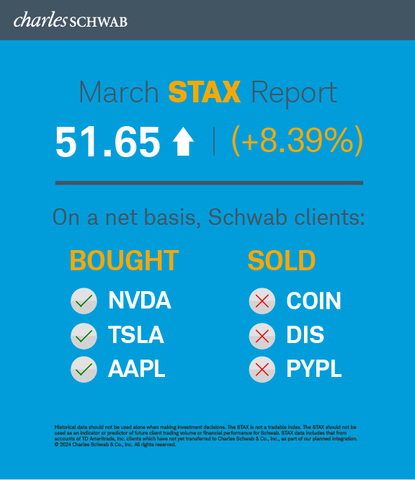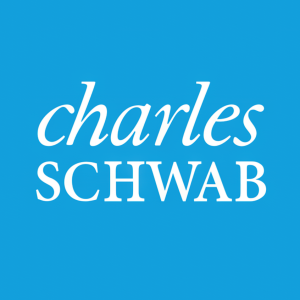Schwab Trading Activity Index™: Score Ascends to Moderate Levels in March
Schwab clients were net buyers in March, with the most pronounced buying within the Information Technology, Health Care, and Consumer Staples sectors

Schwab Trading Activity Index March 2024 (Graphic: Charles Schwab)
The reading for the four-week period ending March 28, 2024 ranks “moderate” compared to historic averages and marks the highest reading since May 2022.
“In the face of undeniably mixed macroeconomic data, the markets soared this month, and the STAX score continued its rise in step,” said Joe Mazzola, Director of Trading and Education at Charles Schwab. “Despite the market highs, however, Schwab clients remain in the moderate range of market exposure as measured by the STAX. They net bought equities in March, but we continue to see that retail investors are engaging in strategic, thoughtful buying. There’s palpable enthusiasm when it comes to names related to technology, for example, but clients also found areas to moderate and trim exposure.”
On March 20,
Popular names bought by Schwab clients during the period included:
- NVIDIA Corp. (NVDA)
- Tesla Inc. (TSLA)
- Apple Inc. (AAPL)
- Advanced Micro Devices Inc. (AMD)
- Palo Alto Networks Inc. (PANW)
Names net sold by Schwab clients during the period included:
- Coinbase Global Inc. (COIN)
- Walt Disney Co. (DIS)
- PayPal Holdings Inc. (PYPL)
- Block Inc. (SQ)
- Netflix Inc. (NFLX)
About the STAX
The STAX value is calculated based on a complex proprietary formula. Each month, Schwab pulls a sample from its client base of millions of funded accounts, which includes accounts that completed a trade in the past month. The holdings and positions of this statistically significant sample are evaluated to calculate individual scores, and the median of those scores represents the monthly STAX.
For more information on the Schwab Trading Activity Index, please visit www.schwab.com/investment-research/stax. Additionally, Schwab clients can chart the STAX using the symbol $STAX in either the thinkorswim® or thinkorswim Mobile platforms.
Investing involves risk, including loss of principal. Past performance is no guarantee of future results.
Content intended for educational/informational purposes only. Not investment advice, or a recommendation of any security, strategy, or account type.
Historical data should not be used alone when making investment decisions. Please consult other sources of information and consider your individual financial position and goals before making an independent investment decision.
The STAX is not a tradable index. The STAX should not be used as an indicator or predictor of future client trading volume or financial performance for Schwab. STAX data includes that from accounts of TD Ameritrade, Inc. clients which have not yet transferred to Charles Schwab & Co., Inc., as part of our planned integration.
TD Ameritrade, Inc., member FINRA/SIPC, a subsidiary of The Charles Schwab Corporation.
About Charles Schwab
At Charles Schwab, we believe in the power of investing to help individuals create a better tomorrow. We have a history of challenging the status quo in our industry, innovating in ways that benefit investors and the advisors and employers who serve them, and championing our clients’ goals with passion and integrity.
More information is available at aboutschwab.com. Follow us on X, Facebook, YouTube, and LinkedIn.
0424-VNCA
View source version on businesswire.com: https://www.businesswire.com/news/home/20240408112995/en/
Margaret Farrell
Director, Corporate Communications
(203) 434-2240
margaret.farrell@schwab.com
Source: The Charles Schwab Corporation







